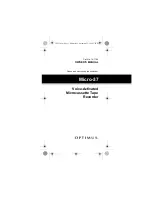
11
Discs (continued)
Discs that cannot be played
≥
DVD-Video with a region number other than the number for this
unit or “All”
≥
Some DVD-R
≥
DVD-RAM (2.6 GB/5.2 GB)
≥
DVD-ROM
≥
DVD-RW
≥
DVD-Audio
≥i
RW
≥
CD-ROM
≥
CDV
≥
CD-G
≥
CVD
≥
SVCD
≥
SACD
≥
MV-Disc
≥
PD
≥
Photo CD
≥
Divx Video Disc, etc.
≥
Play of non-standard Video CDs and Super Video CDs is not
guaranteed.
DVD-R
You can play DVD-R on compatible DVD players by finalizing
[the process that allows recordings on DVD-R to be played on
compatible DVD players, (page 40)] them on this unit,
effectively making them into DVD-Video.
ª
Before finalizing
You can record onto the available space on the disc and perform
editing functions, such as giving titles to discs and programmes
and erasing programmes.
You cannot record to or edit DVD-R with this unit if it was recorded
with another unit, whether it is finalized or not.
You cannot record over parts that have been recorded.
Erasing programmes will not increase the disc’s available time.
ª
After finalizing
The video and audio is recorded according to the DVD-Video
specifications, and your very own DVD-Video is created.
≥
The titles you entered with this unit appear as menus.
≥
Programmes longer than 5 minutes are divided into 5-minute
chapters.
≥
These DVD-R can no longer be recorded on or edited.
≥
These DVD-R can be played on other DVD players, but this is
not guaranteed.
Play may not be possible due to the player you are using, the
DVD-R, or the condition of the recording. Use this unit to play the
disc if the player is unable.
For your reference
≥
It takes about 30 seconds for the unit to complete recording
management information after recording finishes.
≥
To record on DVD-R, this unit optimizes the disc for each
recording. Optimizing is carried out when you start recording
after inserting the disc or turning the unit on. Recording may
become impossible after the disc is optimized more than 50
times.
≥
The first 30 seconds of a programme may not be recorded if you
make successive timer recordings.
≥
The video is recorded in a 4:3 aspect irrespective of the video
signal input. Use the television’s screen modes to change the
screen size for play.
≥
Some broadcasts carry signals that allow you to make one copy,
but you cannot record these broadcast with DVD-R. Use
DVD-RAM to record these kinds of broadcast.
≥
Play may be impossible in some cases due the condition of the
recording.
≥
You cannot change audio type if a DVD-R is in the unit. Select
the audio type (M1 or M2) before recording by going to
“Bilingual Audio Selection” in the “Sound” menu.
Audio format logos
Dolby Digital
(pages 54 and 69)
This unit can play Dolby Digital in stereo
(2 channels). Connect an amplifier with a built-in
Dolby Digital decoder to enjoy surround sound.
DTS Digital Surround
(pages 54 and 69)
Connect this unit to equipment that has a DTS
decoder to enjoy DVDs with this mark.
Types of disc for the type of connected
TV
When you use the discs recorded either PAL or NTSC, refer to this
table.
*
1
If you select “NTSC” in “TV System”
(page 61), the picture may
be clearer.
*
2
If your television is not equipped to handle PAL 525/60 signals
the picture will not be shown correctly.
TV type
Disc
Yes/No
Multi-
system TV
PAL
Yes
NTSC
Yes
NTSC TV
PAL
No
NTSC
Yes*
1
PAL TV
PAL
Yes
NTSC
Yes*
2
(PAL60)
Summary of Contents for DVD-R4000
Page 78: ...78 ...
Page 79: ...79 ...
Page 80: ...RQT6996 B F0103Fa0 Samsung Electronics U K Ltd Web site http www samsungdvd com ...












































